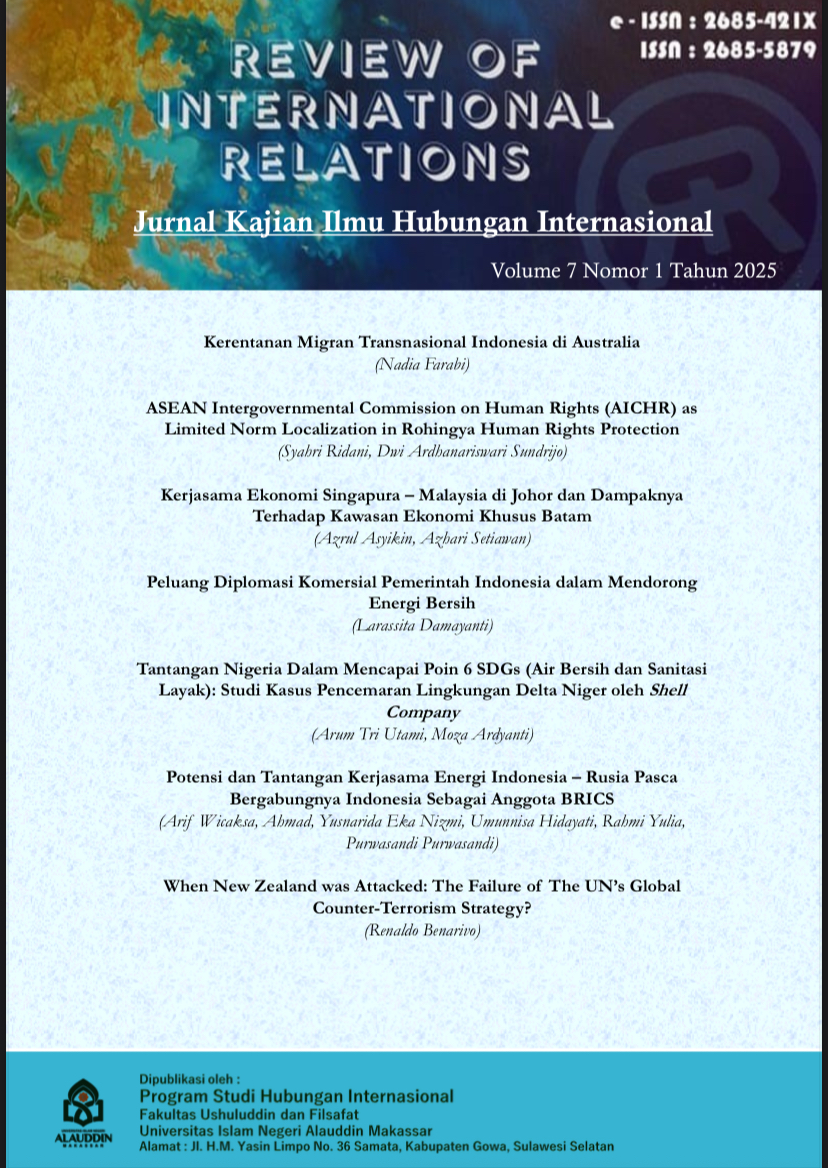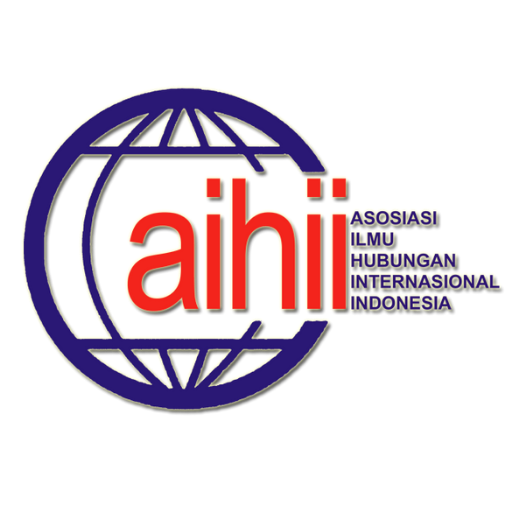ASEAN Intergovernmental Commission on Human Rights (AICHR) as Limited Norm Localization in Rohingya Human Rights Protection
DOI:
https://doi.org/10.24252/rir.v7i1.56792Keywords:
AICHR, ASEAN, Human rights, RohingyaAbstract
This study analyzes how the ASEAN Intergovernmental Commission on Human Rights (AICHR) functions as an outcome of limited norm localization in the protection of human rights for the Rohingya ethnic group. Employing Acharya’s (2004) norm localization theory, the study traces the process of adapting global human rights norms into the ASEAN framework, which faces challenges due to the principles of non-interference and state sovereignty among member countries. The findings reveal that although AICHR was established to promote and protect human rights, it faces structural and functional limitations. its consultative mandate, absence of investigative mechanisms, and the dominance of the ASEAN Way, particularly consensus and non-intervention, render AICHR ineffective in responding to the Rohingya crisis. Analysis through the four stages of localization (contestation, local initiative, adaptation, and amplification) indicates that AICHR functions more as a symbolic commitment to human rights within ASEAN rather than as a genuine protective mechanism. The study concludes that without mandate reform and adjustments to ASEAN principles, AICHR will continue to fall short in addressing systematic human rights violations such as those experienced by the Rohingya. This implies the need for a redefinition of global human rights norms that are more contextually grounded in regional valuesDownloads
References
Acharya, A. (2004). How ideas spread: Whose norms matter? Norm localization and institutional change in Asian regionalism. In International Organization (Vol. 58, Issue 2, pp. 239–275). https://doi.org/10.1017/S0020818304582024
André Asplund (2014) ASEAN Intergovernmental Commission on Human Rights: civil society organizations’ limited influence on ASEAN, Journal of Asian Public Policy, 7:2, 191-199, DOI: 10.1080/17516234.2014.896090
Aljazeera (2018), Who are the Rohingya, di akses di : https://www.aljazeera.com/features/2018/4/18/who-are-the-rohingya
André Asplund (2014) ASEAN Intergovernmental Commission on Human Rights: civil society organizations’ limited influence on ASEAN, Journal of Asian Public Policy, 7:2, 191-199, DOI: 10.1080/17516234.2014.896090
Analisis BBC (2023), Rohingya Negara mana?, di akses di : https://www.bbc.com/indonesia/articles/cjkp8nkp0gyo
Drummond, C. (2010). The ASEAN Intergovernmental Commission on Human Rights (AICHR) and the Responsibility to Protect: Development and Potential Working Paper on ASEAN and R2P No. 1 Responsibility to Protect in Southeast Asia Program ASEAN Intergovernmental Commission on Human Rights (AICHR) and R2P Report No. 1.
Ellen J Randal. (2021). International Organisation in Historical Prespective (1st ed.)
Finnemore, M., & Sikkink, K. (1998). International Organization at Fifty: Exploration and Contestation in the Study of World Politics. In Source: International Organization (Vol. 52, Issue 4). Autumn. https://about.jstor.org/terms
Gultom, F, (2012), ASEAN Selayang Pandang, Jakarta :Direktur Kerjasama ASEAN, Edisi ke-20.
Gamez, K,R, (2017), Examining The ASEAN Intergovermental Commission on Human Rights (AICHR): Case Study of The Rohingya Crisis, Tilburg University: Netherland.
Itasari, E. R. (2020). THE ROLE OF THE ASEAN INTERGOVERNMENTAL COMMISSION OF HUMAN RIGHTS IN PROTECTING THE ETHNIC ROHINGYA IN THE SPIRIT IN SOUTHEAST ASIA. Jurnal IUS Kajian Hukum Dan Keadilan, 8(3), 156–170. https://doi.org/10.29303/ius.v8i3.803
James Munro [email protected] (2011) The relationship between the origins and regime design of the ASEAN Intergovernmental Commission on Human Rights (AICHR), The International Journal of Human Rights, 15:8, 1185-1214, DOI: 10.1080/13642987.2010.511996
Kauppi, M. v., & Viotti, P. R. (n.d.) (2020). International relations theory. London: George University.
Kumala. (2019). More forceful human rights mechanisms needed in ASEAN. Antaranews.
Limsiritong, N, (2017), Why Asean Fails to Play Role in the Rohingya Situation from the Perspective of ASEAN Charter, Bangkok:Asian Political Science Review.
Limsiritong, N., & History, A. (n.d.). The Power Limitation of ASEAN Inter-Governmental Human Rights Commission Under the Perspective of ASEAN Charter in Case of the Rohingya Issue. In International Journal of Crime, Law and Social Issues (Vol. 5, Issue 2). https://ssrn.com/abstract=3318102
Limsiritong, N., & History, A. (2022). The Power Limitation of ASEAN Inter-Governmental Human Rights Commission Under the Perspective of ASEAN Charter in Case of the Rohingya Issue. In International Journal of Crime, Law and Social Issues (Vol. 5, Issue 2).
Lamont, C. (2015). Research Methods in International Relations. London: Sage.
Munro, J. (2011). The relationship between the origins and regime design of the ASEAN intergovernmental commission on human rights (AICHR). International Journal of Human Rights, 15(8), 1185–1214. https://doi.org/10.1080/13642987.2010.511996
Neuman, W. L. (2014). Social Research Methods: Qualitative and Quantitative Approaches Seventh Edition. Essex: Pearson.
Piromya. (2019). Time to rethink ASEAN’s rights body. Aseanmp.
Saputra, O. B. (2019). PERAN ASEAN INTERGOVERNMENTAL COMMISSION ON HUMAN RIGHTS SEBAGAI INSTITUSI HAM ASEAN: KASUS ROHINGYA DI MYANMAR 2012-2016. In Journal of International Relations (Vol. 5). http://ejournal-s1.undip.ac.id/index.php/jihiWebsite:http://www.fisip.undip.ac.id
Downloads
Published
How to Cite
Issue
Section
License
Copyright (c) 2025 Syahri Ridani, Dwi Ardhanariswari Sundrijo

This work is licensed under a Creative Commons Attribution-ShareAlike 4.0 International License.




